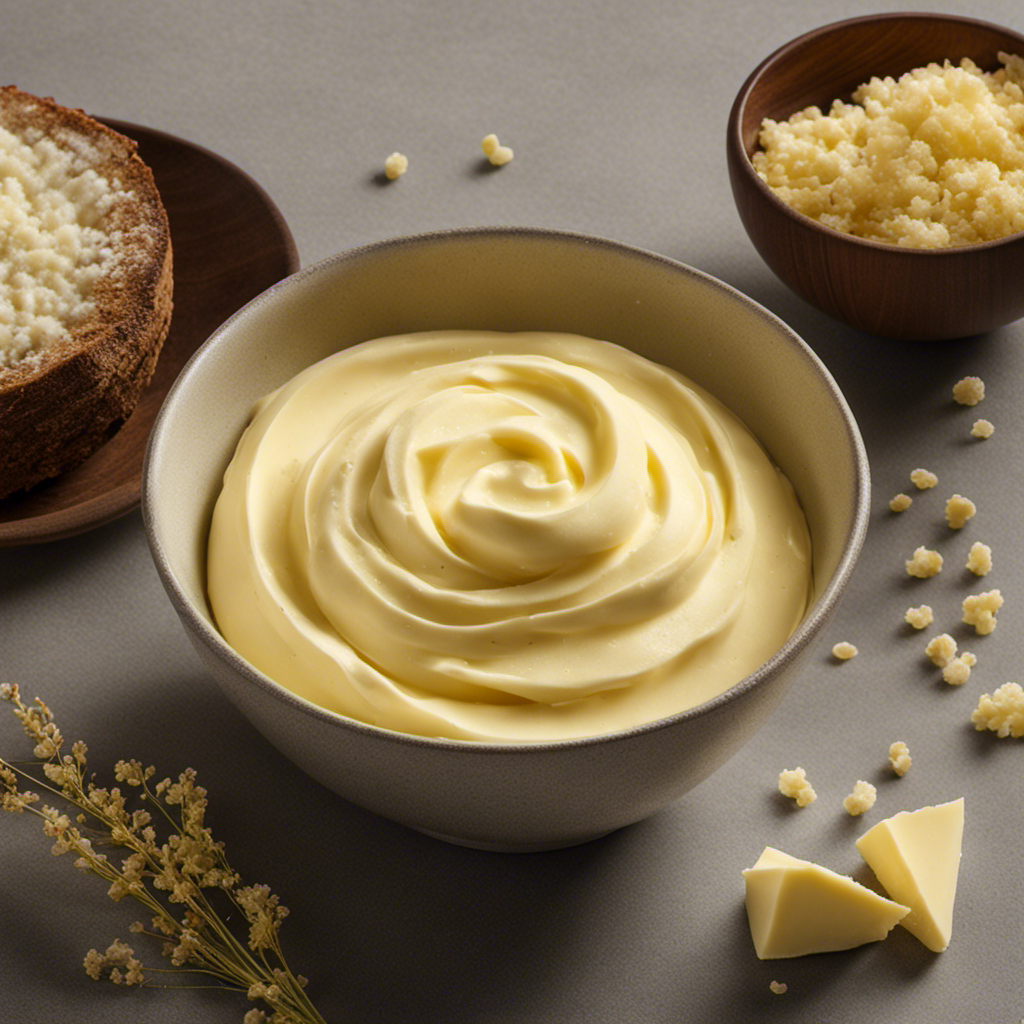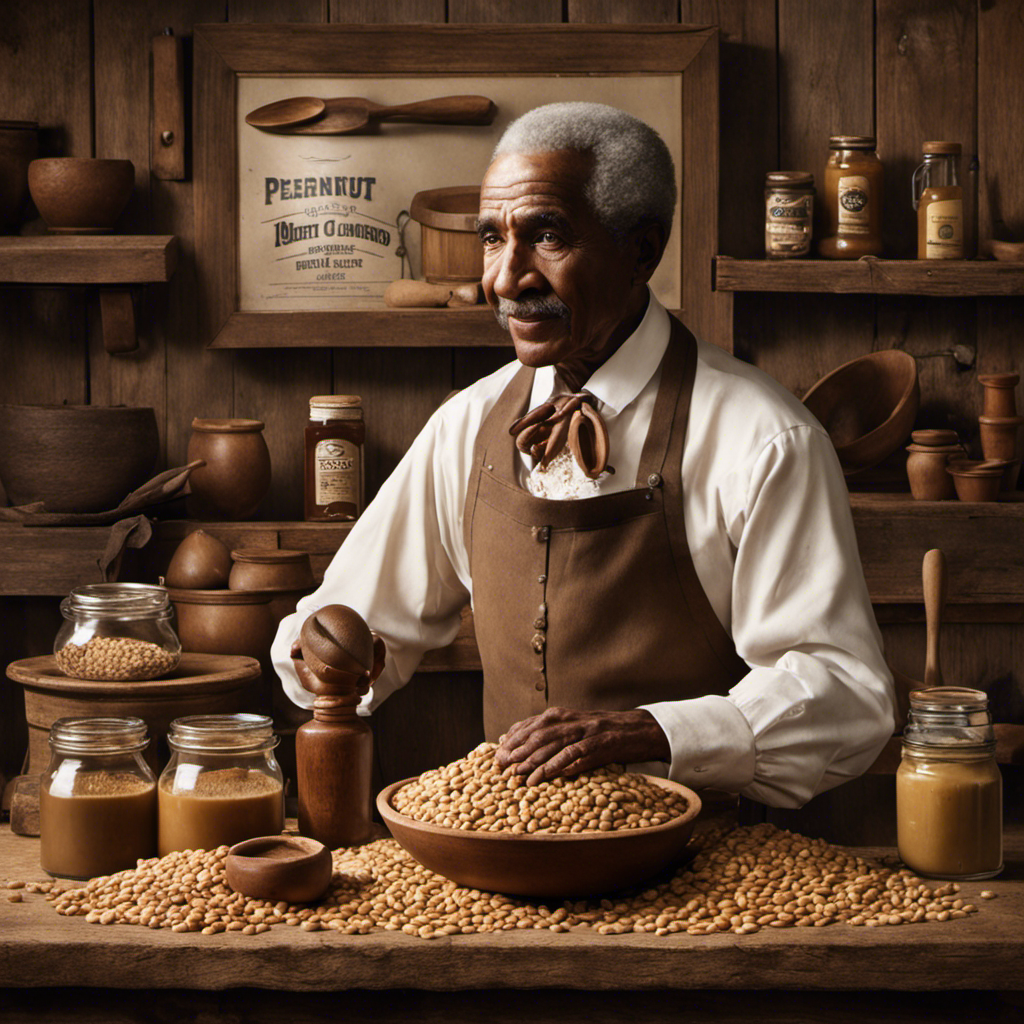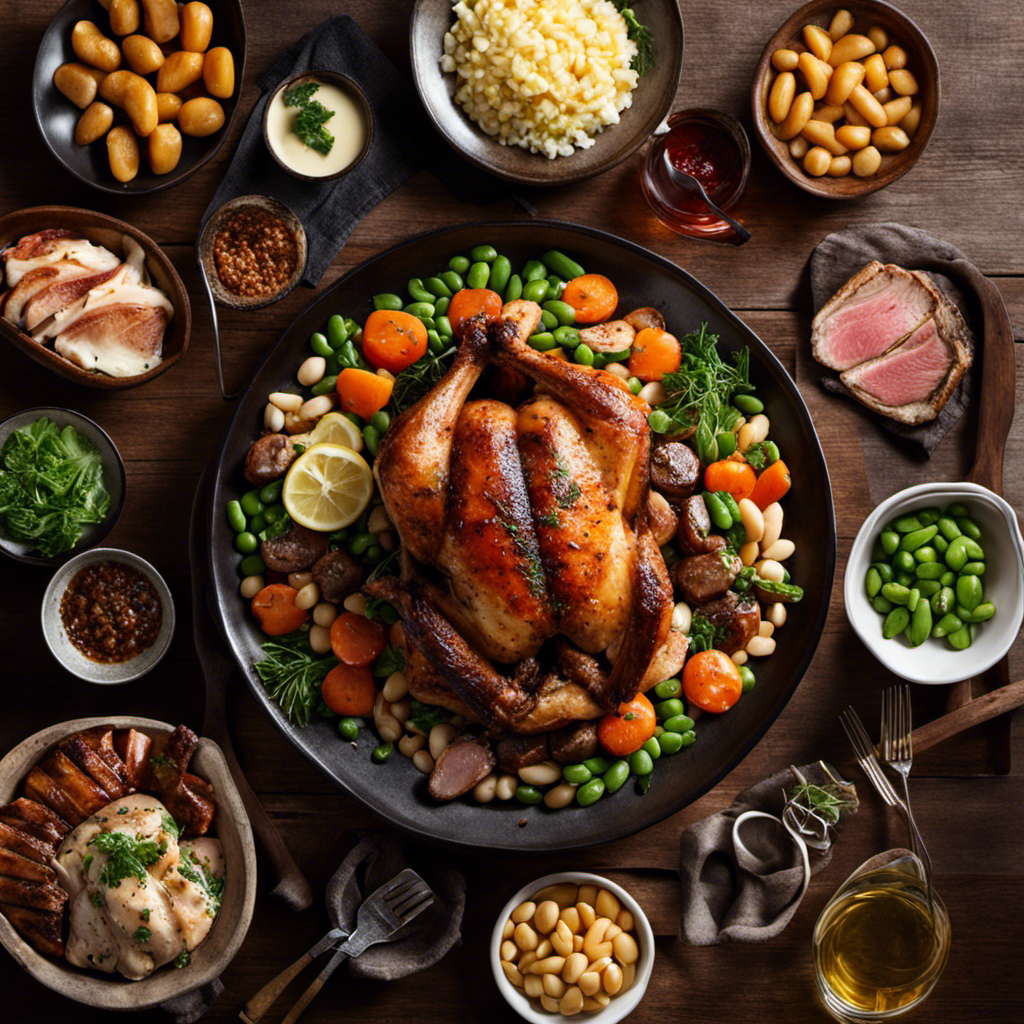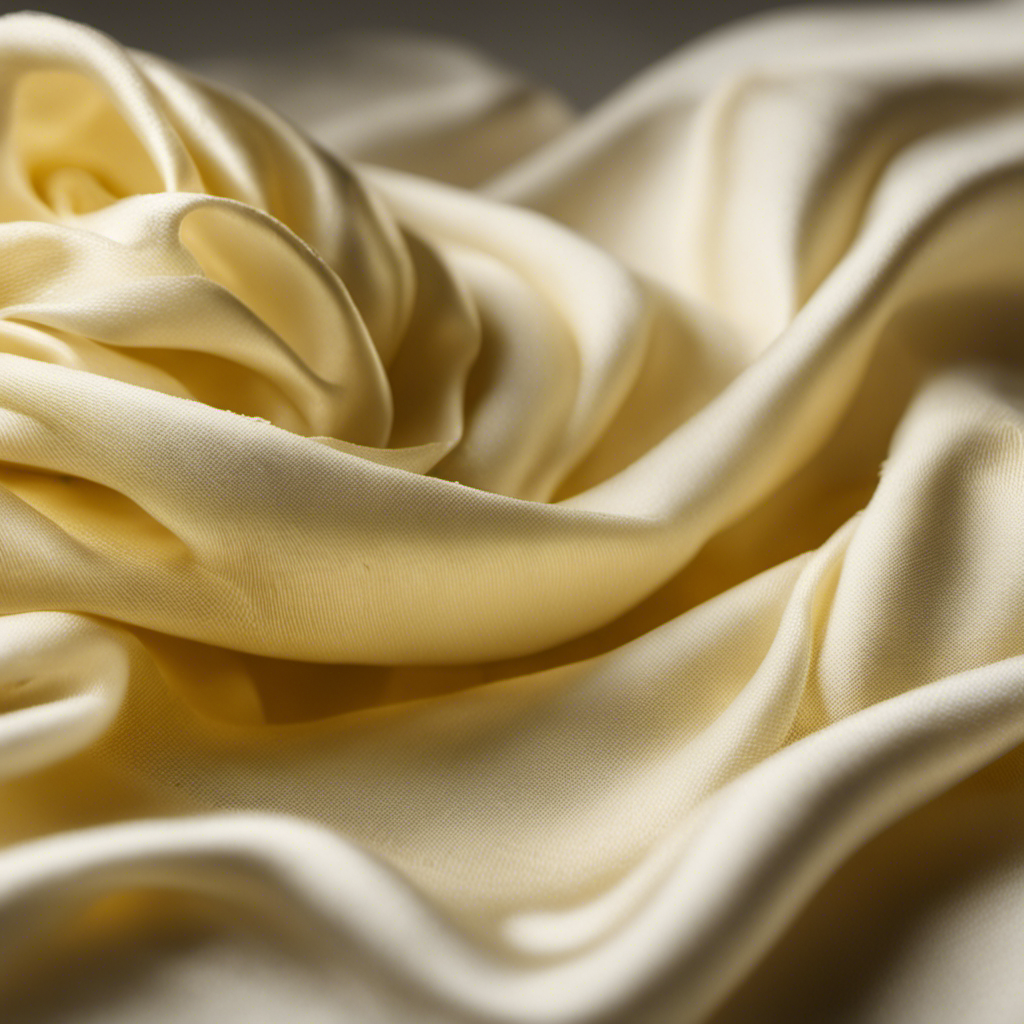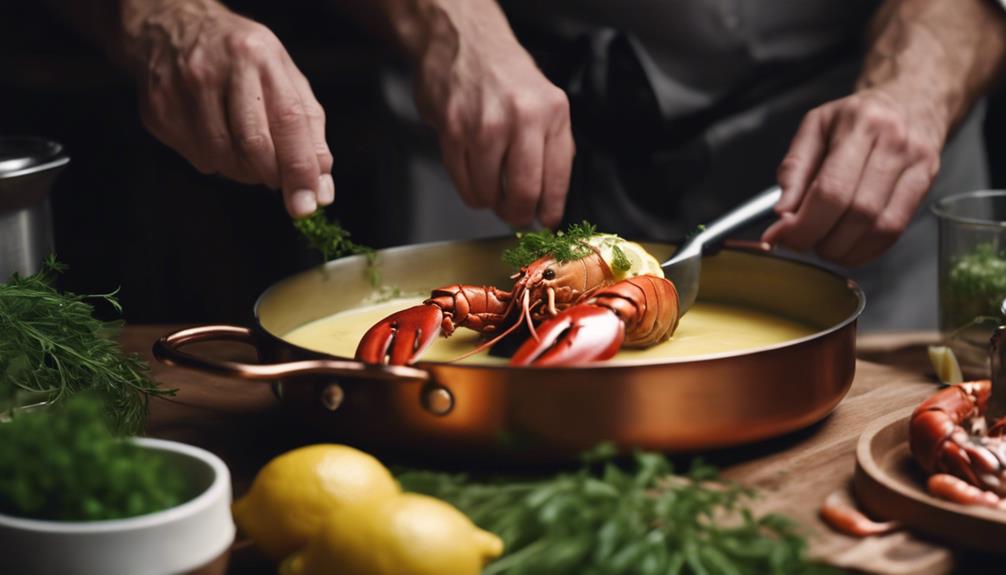I have always been fascinated by the world of butter. Did you know that cultured butter has been around for centuries? It has played a vital role in many culinary traditions worldwide.
So, what exactly is cultured butter? Well, let me break it down for you. Cultured butter is made by fermenting cream, which gives it a tangy and complex flavor.
In this article, we’ll explore the origins, differences, and even how to make this delectable ingredient at home. So, let’s dive into the world of cultured butter together!
Key Takeaways
- Cultured butter is made by fermenting cream with lactic acid bacteria, giving it a tangy flavor and creamy texture.
- It contains higher amounts of beneficial bacteria and vitamins A, D, and K compared to regular butter.
- The longer the fermentation period, the more pronounced the flavors become, with nutty and rich notes.
- Cultured butter can be made at home by fermenting cream with cultured buttermilk or yogurt for 24 hours.
The Origins of Cultured Butter
You might be wondering where cultured butter actually comes from. Well, let me enlighten you.
Cultured butter is a result of cultural evolution in the world of dairy products. It originated from the practice of fermenting cream with lactic acid bacteria, which has been around for centuries. This traditional method allows the cream to undergo a process of fermentation, giving the butter a distinct tangy flavor and a creamy texture.
Not only does this fermentation process add a unique taste, but it also offers health benefits. The lactic acid bacteria present in cultured butter are beneficial for digestion and can help improve gut health.
Now that we understand the origins and health benefits of cultured butter, let’s explore the difference between cultured butter and regular butter.
The Difference Between Cultured Butter and Regular Butter
When comparing cultured butter and regular butter, two key points to consider are the culturing process and flavors, as well as the nutritional benefits.
The culturing process of cultured butter involves adding live bacteria cultures to cream before churning, which gives it a distinct tangy flavor.
In terms of nutritional benefits, cultured butter is often considered healthier than regular butter due to its higher content of beneficial bacteria and vitamins.
Culturing Process and Flavors
The culturing process gives cultured butter its distinct flavors. Through fermentation, the natural bacteria present in milk convert lactose into lactic acid, which enhances the flavor development of the butter.
The fermentation benefits are twofold. Firstly, it creates a tangy and slightly acidic taste, adding complexity to the butter’s profile. Secondly, it helps to break down the milk proteins, resulting in a smoother and creamier texture.
This process also contributes to the unique aroma of cultured butter, with notes of nuttiness and richness. The longer the fermentation period, the more pronounced these flavors become.
Overall, the culturing process plays a crucial role in elevating the taste and texture of cultured butter, making it a favorite among culinary enthusiasts and chefs alike.
Nutritional Benefits Comparison
One notable difference in the nutritional benefits of cultured butter compared to regular butter is its higher content of vitamins A, D, and K. Cultured butter is made by fermenting cream with lactic acid bacteria, which enhances its flavor and texture. But it also brings some health advantages. The table below highlights the nutritional benefits of cultured butter:
| Nutrient | Regular Butter | Cultured Butter |
|---|---|---|
| Vitamin A | 355 IU | 500 IU |
| Vitamin D | 60 IU | 90 IU |
| Vitamin K | 7 mcg | 12 mcg |
As we can see, cultured butter provides higher amounts of these essential vitamins compared to regular butter. Vitamin A is important for vision and immune function, vitamin D is crucial for bone health, and vitamin K helps with blood clotting. Incorporating cultured butter into your diet can be a simple way to boost your nutritional intake and support overall wellbeing.
How to Make Cultured Butter at Home
When it comes to making cultured butter at home, there are a few key points to consider.
First, you’ll need the right ingredients and equipment, such as high-quality cream and a food processor or stand mixer.
Next, understanding the fermentation process is crucial, as it’s what gives cultured butter its distinct flavor and texture.
Ingredients and Equipment
To make cultured butter, you’ll need a few key ingredients and some basic equipment. The fermentation process is what gives cultured butter its unique flavor and tanginess. Here is a list of the ingredients and equipment you’ll need:
| Ingredients | Equipment |
|---|---|
| Heavy cream | Glass jar or container |
| Cultured buttermilk or yogurt | Cheesecloth or fine-mesh strainer |
| Salt (optional) | Mixing bowl |
Start by pouring the heavy cream into a glass jar or container. Add a couple of tablespoons of cultured buttermilk or yogurt to the cream and mix well. Cover the jar loosely with a cheesecloth or fine-mesh strainer and let it sit at room temperature for about 24 hours, allowing the fermentation process to occur. Once fermented, strain the mixture to separate the butter solids from the liquid. Rinse the butter solids with cold water to remove any remaining liquid. Finally, knead the butter solids to remove any excess liquid and shape it into a desired form. You now have homemade cultured butter ready to be enjoyed!
Fermentation Process Explained
Mix the heavy cream with a few tablespoons of cultured buttermilk or yogurt and let it sit at room temperature for about 24 hours, allowing the fermentation process to occur.
During this time, the beneficial bacteria in the cultured buttermilk or yogurt will convert the lactose in the cream into lactic acid. This lactic acid will help to break down the proteins in the cream, resulting in a tangy flavor and a thickened texture.
As the cream ferments, you may notice a slight sour smell, which is a sign that the fermentation process is working. The longer you allow the cream to ferment, the stronger the tangy flavor will become.
Once the fermentation process is complete, you can proceed with the next steps to make butter.
Tips for Perfect Butter
Make sure you have fresh heavy cream, as it is the key ingredient for perfect butter.
To achieve the best results, start by chilling the cream to about 50°F. This temperature allows for better control during the churning process.
Next, pour the cream into a stand mixer fitted with a whisk attachment. Begin whisking at a low speed, gradually increasing it to medium-high.
Keep an eye on the mixture as it thickens and separates into butter and buttermilk. Once the butter forms solid clumps, stop the mixer and strain out the buttermilk.
Rinse the butter under cold water to remove any remaining buttermilk, as it can cause spoilage.
The Benefits of Using Cultured Butter in Cooking
When cooking, you’ll love the added depth of flavor that using cultured butter brings to your dishes. Cultured butter is made by fermenting cream with lactic acid bacteria, which gives it a tangy and rich taste.
Here are some benefits of using cultured butter in your cooking:
-
Enhanced Flavors: The fermentation process of cultured butter creates complex flavors that can elevate any dish. It adds a nutty, slightly sour taste that complements both sweet and savory recipes.
-
Health Benefits: Cultured butter contains beneficial bacteria that promote a healthy gut. Additionally, it is lower in lactose and higher in vitamins A, D, and E compared to regular butter.
-
Creamy Texture: Cultured butter has a creamier texture due to its higher fat content, making it perfect for spreading on toast or adding richness to sauces and baked goods.
By incorporating cultured butter into your cooking, you’ll unlock a world of delicious flavors and enjoy the added health benefits it offers.
Now, let’s explore the flavor profile of cultured butter in more detail.
Exploring the Flavor Profile of Cultured Butter
When it comes to enhancing culinary creations, one important aspect to consider is the flavor profile of the ingredients used.
In the case of cultured butter, there is a distinct difference between tangy and sweet variations.
Tangy cultured butter can add a lively and acidic note to dishes, while sweet cultured butter brings a subtle sweetness that can complement both savory and sweet dishes.
Understanding the nuances between these two flavors can help chefs and home cooks elevate their dishes to new heights.
Tangy Versus Sweet
If you’re looking for a tangy flavor, you’ll love how cultured butter adds a delightful zing to your recipes.
Cultured butter is made by fermenting cream with live bacteria cultures, giving it a unique taste and texture.
Here are some reasons why you should give this tangy delight a try:
-
The tangy flavor of cultured butter is reminiscent of sour cream or crème fraîche, adding a pleasant acidity to your dishes.
-
The fermentation process in cultured butter enhances its health benefits by increasing the levels of probiotics, which can promote a healthy gut and boost your immune system.
-
When used in baking, the tanginess of cultured butter can balance out the sweetness of desserts, creating a more complex and balanced flavor profile.
Enhancing Culinary Creations?
Looking to enhance your culinary creations? Try incorporating tangy and flavorful cultured butter into your recipes for a delightful twist.
Cultured butter is made by fermenting cream with live bacteria cultures, which gives it a tangy and complex flavor profile. This process also enhances the natural flavors of the butter, making it a perfect ingredient to elevate the taste of your dishes.
But the benefits of cultured butter go beyond its taste. It is rich in vitamins A, D, E, and K, which support a healthy immune system, bone health, and skin health. Additionally, the live cultures in cultured butter promote gut health by aiding digestion and maintaining a healthy balance of bacteria in the gut.
The Science Behind Cultured Butter
To understand the science behind cultured butter, you need to know that it is made by fermenting cream with lactic acid bacteria. This fermentation process benefits the butter in several ways.
First, the bacteria consume the lactose present in the cream, transforming it into lactic acid. This gives the butter a tangy flavor and contributes to its creamy texture.
Second, the fermentation process creates compounds called diacetyl and acetoin, which are responsible for the rich and buttery aroma of cultured butter.
Lastly, cultural variations in butter making can result in different strains of lactic acid bacteria being used, leading to unique flavor profiles and characteristics in the final product.
Cultured Butter Vs. Margarine: Which Is Healthier
When it comes to comparing cultured butter and margarine, you’ll want to consider which option is healthier for you.
Cultured butter, made from fermented cream, offers several health benefits compared to margarine. Firstly, cultured butter contains beneficial bacteria that can aid in digestion and improve gut health. Additionally, it is a natural source of vitamins A, D, E, and K, which are important for various bodily functions.
Margarine, on the other hand, is a processed product that often contains artificial additives and trans fats, which can increase the risk of heart disease.
In terms of culinary uses, cultured butter adds a rich and tangy flavor to dishes and is perfect for baking, sautéing, and spreading on toast. It can also be used to make delicious recipes like croissants, pie crusts, and hollandaise sauce.
Overall, when it comes to health benefits and culinary versatility, cultured butter is the superior choice over margarine.
The Role of Cultured Butter in Traditional Cuisine
When discussing the role of cultured butter in traditional cuisine, it is essential to consider its historical significance.
Cultured butter has been a staple in many cultures for centuries, with its origins dating back to ancient times. Traditional recipes using cultured butter have been passed down through generations, showcasing its versatility and unique flavor profile.
Furthermore, cultural variations in butter-making techniques have resulted in a diverse range of flavors and textures, making it an intriguing topic to explore in the culinary world.
Historical Significance of Cultured Butter
If you want to learn about the historical significance of cultured butter, you’ll find that it has been enjoyed for centuries by many cultures around the world. Cultured butter has deep historical origins and has been a staple in various traditional cuisines.
Here are some cultural variations that showcase the diverse history of this delectable spread:
-
In France, artisanal cultured butter was highly regarded and produced using traditional methods, often made from fermented cream.
-
In India, ghee, a form of cultured butter, played a significant role in Ayurvedic medicine and was used for cooking, religious ceremonies, and skincare.
-
In Scandinavia, cultured butter was made using traditional buttermilk cultures and was a vital ingredient in traditional Scandinavian pastries.
The historical origins and cultural variations of cultured butter provide a fascinating glimpse into the rich culinary traditions of different regions around the world.
Traditional Recipes Using Cultured Butter
Traditional recipes using cultured butter can add a rich and flavorful touch to a variety of dishes. Cultured butter, made using traditional butter making techniques, is known for its distinct tangy flavor and creamy texture.
In many cultures, using cultured butter is not only about enhancing the taste of the dish but also about preserving cultural customs. For example, in French cuisine, using cultured butter is considered essential for making croissants and other pastries. In Indian cuisine, ghee, a form of cultured butter, is used for cooking and is believed to have medicinal properties. In Scandinavian countries, cultured butter is often served alongside traditional breads and is an integral part of their culinary heritage.
These cultural customs around using cultured butter demonstrate how this ingredient has stood the test of time and continues to be cherished in various cuisines around the world.
Cultural Variations in Butter-Making
Cultural variations in butter-making can result in unique flavors and textures that add depth to regional cuisines. Each culture has its own traditional methods and techniques, passed down through generations, that contribute to the distinctiveness of their butter.
Here are three examples of cultural traditions in butter-making:
-
In France, the process of making cultured butter involves allowing cream to ferment before churning. This creates a tangy flavor and a creamy texture that is highly valued in French cuisine.
-
In India, ghee, a form of clarified butter, is a staple in many dishes. The butter is heated slowly, allowing the water content to evaporate and resulting in a rich, nutty flavor.
-
In Scandinavia, traditional butter-making involves using sour cream instead of regular cream. This produces a creamy, slightly tangy butter that is perfect for spreading on bread or enhancing the flavors of traditional Scandinavian dishes.
Beyond their cultural significance, these variations in butter-making techniques also offer health benefits. Cultured butter contains probiotics, which promote gut health and aid in digestion. So, not only does butter add flavor and richness to cuisines around the world, but it also contributes to overall well-being.
Cultured Butter and Its Role in Baking
Cultured butter adds a rich and tangy flavor to baked goods. It is made using traditional baking techniques, where cream is cultured with live bacteria before churning. This process enhances the taste and texture of the butter, making it a favorite among bakers.
In addition to its delicious flavor, cultured butter also offers health benefits. The live bacteria present in cultured butter help in the digestion of lactose, making it easier to digest for those with lactose intolerance. It also contains higher levels of beneficial fatty acids like omega-3 and omega-6, which contribute to heart health. Moreover, the fermentation process increases the availability of certain vitamins and minerals in the butter.
Transitioning to the nutritional value of cultured butter, it is important to understand the impact it has on our overall well-being.
The Nutritional Value of Cultured Butter
When it comes to the nutritional value of this type of butter, you’ll be pleased to know that it contains higher levels of beneficial fatty acids and increased availability of certain vitamins and minerals.
The rich, creamy texture of cultured butter melts in your mouth, making every bite a delight. Its tangy, slightly nutty flavor adds a depth of taste to both sweet and savory dishes. The golden yellow color of cultured butter comes from the high content of beta-carotene, which is converted to vitamin A in the body.
Incorporating cultured butter into a balanced diet can have numerous health benefits. The high levels of beneficial fatty acids, such as omega-3 and conjugated linoleic acid (CLA), can improve heart health and reduce inflammation. The increased availability of vitamins and minerals, like vitamin K2 and butyrate, can support bone health and improve gut function. Cultured butter is also a good source of fat-soluble vitamins, including vitamin A, E, and D.
Cultured Butter as a Gourmet Ingredient
Indulge in the versatility of this gourmet ingredient and discover the endless culinary possibilities it brings to your dishes. Cultured butter, with its rich and tangy flavor, is a popular choice among chefs and food enthusiasts alike. It adds a unique depth of flavor to both sweet and savory recipes.
From flaky croissants to creamy mashed potatoes, cultured butter can elevate any dish to new heights. But it’s not just about taste; there are also health benefits to consider. Cultured butter contains probiotics, which promote gut health and aid digestion. Additionally, it is a good source of vitamins A, D, and K2, which are essential for maintaining strong bones and a healthy immune system.
Now, let’s delve into the cultural significance of this beloved ingredient.
The Cultural Significance of Cultured Butter
With its rich history and deep cultural roots, cultured butter has been cherished by various culinary traditions around the world. This gourmet ingredient not only adds a unique flavor to dishes but also offers numerous health benefits.
The butter is made using traditional methods passed down through generations, preserving cultural traditions and techniques.
Made from fermented cream, cultured butter has a tangy and complex flavor profile that enhances the taste of baked goods, sauces, and spreads.
The process of fermenting the cream creates beneficial bacteria that aid in digestion and improve gut health.
Cultured butter has become a staple in many cuisines, from European pastries to Indian curries. Its cultural significance lies in its ability to elevate dishes while providing nourishment and promoting good health.
The Art of Churning Cultured Butter
The process of churning cultured butter involves mixing the fermented cream until it transforms into a creamy and spreadable consistency.
Cultured butter offers numerous benefits for skincare. Its high fat content helps moisturize the skin, leaving it soft and supple. The natural lactic acid in cultured butter acts as a gentle exfoliant, removing dead skin cells and improving skin texture. Additionally, the vitamins A, E, and K found in cultured butter promote skin health and repair.
However, it is important to consider the environmental impact of cultured butter production. The production of cultured butter requires a significant amount of cream, which in turn requires large quantities of milk. This can contribute to increased demand for dairy farming, which has its own environmental consequences such as land degradation, water pollution, and greenhouse gas emissions.
Therefore, it is important to consume cultured butter in moderation and consider sustainable alternatives for skincare.
Exploring Different Varieties of Cultured Butter
Have you tried exploring the different varieties of cultured butter available? It’s truly a culinary adventure! When it comes to enhancing flavors, cultured butter offers a world of possibilities.
Here are some varieties that will transport your taste buds to new heights:
-
European Style: Rich and creamy, with a tangy undertone that adds depth to any dish.
-
Salted Cultured Butter: The perfect balance of salt and tang, elevating both sweet and savory creations.
-
Herb-infused Cultured Butter: Imagine the earthy aroma of rosemary or the delicate freshness of basil infused into every bite.
Not only do these varieties enhance flavors, but they also offer health benefits. Cultured butter contains beneficial bacteria that aid in digestion and promote a healthy gut. So, why not embark on a journey of flavors and reap the health benefits of cultured butter? Your taste buds and body will thank you!
Frequently Asked Questions
Can Cultured Butter Be Used as a Substitute for Regular Butter in Baking?
Yes, cultured butter can be used as a substitute for regular butter in baking. Its tangy flavor profile and rich texture add depth to baked goods. Additionally, it offers the benefits of being easier to digest and having a higher smoke point.
Is Cultured Butter Suitable for Lactose-Intolerant Individuals?
Yes, cultured butter is suitable for lactose-intolerant individuals. It is made by fermenting cream, which breaks down lactose. Additionally, it offers health benefits like a rich source of probiotics and higher concentration of vitamins.
How Long Does It Take to Culture Butter at Home?
It takes about 24-48 hours to culture butter at home. Culturing butter at home has several advantages, such as enhancing flavor, improving texture, and increasing the health benefits of the final product.
Can Cultured Butter Be Used in Savory Dishes?
Yes, absolutely! Cultured butter adds a delicious tangy flavor to savory dishes. It enhances the taste of roasted vegetables, grilled meats, and even savory sauces. It’s one of my favorite cooking tips for elevating flavor profiles.
What Is the Shelf Life of Cultured Butter?
The shelf life of cultured butter can vary, but it is typically around 2-3 months when stored properly in the refrigerator. Using cultured butter in cooking enhances flavors and adds a tangy richness to dishes.
Conclusion
In conclusion, cultured butter is a delicious and versatile ingredient that adds a unique flavor and richness to any dish.
It is fascinating to note that according to a study conducted by the American Butter Institute, the demand for cultured butter has been steadily increasing over the past decade, with a 20% growth in sales in the last year alone.
This statistic emphasizes the growing popularity and appreciation for the distinct taste and quality of cultured butter among consumers.
Whether used in baking, cooking, or simply enjoyed spread on warm bread, cultured butter is a true culinary delight.
